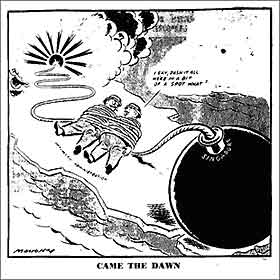| Contents > “Roar Britannia?” by Bridget Deane |
| Page 1 | 2 | 3 | 4 | 5 | 6 |
Interestingly, I have found no cartoons that allude to the ineffectiveness of the armed forces in Malaya. Perhaps it was taboo or an unwritten rule that there was no reference to military failure in editorial cartoons. After all, the cartoons were there primarily to entertain and raise a smile, not criticise the men of the forces. Military commanders, however, were openly criticised in the Australian and British newspapers, for example, Air Chief Marshal Brooke-Popham, Commander-in-Chief (Malaya) and later his replacement, General Pownall. The Daily Mirror (London) reported that Brooke-Popham had been
-
recently subjected to severe criticism in the Australian Press for his handling of affairs in Malaya since the Japanese attack began. The Sydney Daily Telegraph accused him of “fatuous optimism” and asked: “What mistakes must be made by high officers before they are sacked?”
(Our Far East C-in-C Sacked, Daily Mirror, December 27, 1941)
An editorial in the Daily Mirror (Singapore, January 13, 1942) commented,
-
General Pownall has announced that Singapore will be defended to the last. We believe him. Yet we may be excused if the familiar ring of defiant words does not convince us that mechanised battles can be won by bravado. Our hearts do not sink after such messages; they remain in a state of suspended animation governed by doubt. The doubt is: Have the Singapore Pukka Sahibs woken up too late?
Does this editorial reflect popular opinion about the news from Singapore? The article implies that people in Britain were not convinced by Pownall’s optimistic statement, and that the ‘Pukka Sahibs’, presumably meaning the British civil administration in Malaya, had reacted too slowly to the crisis facing them. Editorial cartoons provide further evidence of how the general public viewed the situation – although, perhaps the Press directing them what to think.
In fact the colonial administration in Malaya came under fierce attack from the Press and others for its lack of action and forethought during the defence and retreat down the peninsula to Singapore. Certainly the British in Malaya were seen as running away, leaving the armed forces to sort out the mess as the cartoon below demonstrates (Fig.5).

Figure 5. The Star (London) January 13, 1942,
Wyndham Robinson
According to an article in The Argus ("Purge of Pansies", 6 January, 1942) a British MP, Ness Edwards, called for a ‘“purge of pansies” from responsible positions in overseas territories’. It was these ‘“hyphenated be-monocled school-tie wallahs”’ who were to blame for the lack in preparation of Far East defences. Sir Charles Brook, White Rajah of Sarawak expressed similar views. He called for the sacking of ‘Singapore brass-hats, old-school-tie, la-di-da incompetents and others responsible for the fantastic Malaya position’, so reported the Daily Express (London). ‘“People will be out for somebody’s blood over this awful mess,” he said … “There will be a tremendous flare-up in England”’ (Rajah Forecasts "flare-up", 16 January, 1942)
Figure 6 is a visual example of how the colonial administration was perceived: two portly wallahs find themselves ‘in a bit of a spot’, bound up in the fuse for a bomb (Singapore). The caption ‘CAME THE DAWN’ is very apt, describing the realisation that the situation in Malaya was very serious and that Singapore was under great threat. This view is borne out by the cartoon in Figure7 where a little bird cowers under the leering tiger (Japan). The label (‘underestimation’) sums up very neatly that the assessment of Japanese capabilities had been misguided. Note how the tiger has been drawn with instantly recognisable features – slanted eyes, goofy teeth and a moustache – that is how the enemy were caricaturised at the time and reflects the general perception that people had of them: ‘Popular cartoon images of the Japanese promoted the idea of tiny, strutting men in glasses brandishing swords, with buck-tooth grins and slanted slits for eyes’ (Warren, 2002, p. 46). The caricature of Japanese in cartoons and posters as a myopic, grinning buffoons actually turned out to be highly inaccurate; Japanese soldiers were well trained, disciplined fighters much to the surprise of the Allied forces who faced them.


(from left to right) Figure 6. Sydney Daily Telegraph, January 16, 1942
Bill Mahony
Written under the two wallahs is ‘OPTIMISITC ADMINISTRATION’ / Figure 7. The Argus, January 12, 1942 Mick Armstrong
The label attached to the bird reads‘UNDERESTIMATION’
| Page 1 | 2 | 3 | 4 | 5 | 6 |
| Contents > “Roar Britannia?” by Bridget Deane |
